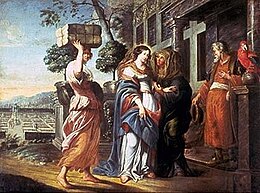BWV 147
|
Herz und Mund und Tat und Leben BWV 147 |
|
|---|---|
| Church cantata by J. S. Bach | |

Heimsuchung, topic of the cantata
|
|
| Related | based on BWV 147a |
| Occasion | Visitation |
| Performed | 2 July 1723: Leipzig |
| Movements | 10 in two parts |
| Cantata text |
|
| Chorale | by Martin Janus |
| Vocal | SATB choir and solo |
| Instrumental |
|
Johann Sebastian Bach composed the church cantata Herz und Mund und Tat und Leben (Heart and mouth and deed and life),BWV 147, in 1723 during his first year as Thomaskantor, the director of church music in Leipzig. His cantata is part of his first cantata cycle there and was written for the Marian feast of the Visitation on 2 July, which commemorates Mary's visit to Elizabeth as narrated in the Gospel of Luke in the prescribed reading for the feast day. Bach based the music on his earlier cantata BWV 147a, written originally in Weimar in 1716 for Advent. He expanded the Advent cantata in six movements to ten movements in two parts in the new work. While the text of the Advent cantata was written by the Weimar court poet Salomo Franck, the librettist of the adapted version who added several recitatives is anonymous.
Bach began the cantata with a chorus for the full orchestra, followed by alternating recitatives and arias with often obbligato instrument. He scored it for four vocal soloists, a four-part choir, and a Baroque instrumental ensemble of trumpet, two oboes, strings, and continuo. The closing chorale of the earlier work was replaced by the hymn "Jesu, meiner Seelen Wonne" (1661) by Martin Janus, with a melody by Johann Schop. Two of its stanzas close the two parts of the cantata in an identical setting. While Bach often composed four-part chorales to end a cantata, he embedded such a setting here in a pastoral instrumental concerto. This music became famous in a piano transcription by Dame Myra Hess as Jesu, Joy of Man's Desiring.
...
Wikipedia
